W-Band GaAs pHEMT Power Amplifier MMIC Stabilized Using Network Determinant Function
Abstract
1. Introduction
2. Circuit Design
2.1. 0.1 μm GaAs pHEMT Process
2.2. Network Determinant Function
3. Measurement
4. Conclusions
Author Contributions
Funding
Data Availability Statement
Conflicts of Interest
References
- Lee, B.H.; An, D.; Lee, M.K.; Lim, B.O.; Kim, S.D.; Rhee, J.K. Two-stage broadband high-gain W-band amplifier using 0.1-μm metamorphic HEMT technology. IEEE Elctron Device Lett. 2004, 25, 766–768. [Google Scholar] [CrossRef]
- Kim, B.; Tran, A.; Schellenberg, J. Full W-band power amplifier/combiner utilizing GaAs technology. In Proceedings of the 2012 IEEE/MTT-S International Microwave Symposium Digest, Montreal, QC, Canada, 17–22 June 2012. [Google Scholar]
- Hong, S.E.; Kim, I.E.; Bang, S.C. Trends of technology developments for mm-wave based 5G communications. Electron. Telecommun. Trends 2013, 28, 107–117. [Google Scholar]
- Jang, S.H.; Kong, S.W.; Lee, H.D.; Park, J.H.; Kim, K.S.; Lee, K.C. Millimeter and terahertz wave circuit and system technologies and trends for future mobile communications. Electron. Telecommun. Trends 2018, 33, 1–12. [Google Scholar]
- Kim, K.Y.; Kim, G.S.; Myung, J.H.; Yoon, C.H.; Shin, W.; Kim, C.S.; Moon, S.H.; Kim, K.P.; Kim, T. Research trends on limitless connections in wireless transmission and access technologies. Electron. Telecommun. Trends 2019, 34, 61–74. [Google Scholar]
- Barabi, A.; Ross, N.; Wolfman, A.; Shaham, O.; Socher, E. A +27 dBm psat 27 dB gain W-band power ampflier 0.1 μm GaAs. In Proceedings of the 2018 IEEE/MTT-S International Microwave Symposium, Philadelphia, PA, USA, 10–15 June 2018. [Google Scholar]
- Trew, R.J. Wide bandgap semiconductor transistors for microwave power amplifiers. IEEE Microw. Mag. 2000, 1, 46–54. [Google Scholar] [CrossRef]
- Ge, Q.; Liu, W.; Xu, B.; Qian, F.; Yao, C. A 77–100 GHz power amplfier using 0.1-μm GaAs pHEMT technology. J. Semicond. 2017, 38, 035001. [Google Scholar] [CrossRef]
- Whelan, C.S.; Marsh, P.F.; Hoke, W.E.; McTaggart, R.A.; Lyman, P.S.; Leminias, P.J.; Lardizabal, S.M.; Leoni, R.E.; Lichwala, S.J.; Kazior, T.E. Millimeter-wave low noise and high power metamorphic HEMT amplifier on GaAs subtsrates. IEEE J. Solid State Circuits 2000, 35, 1307–1311. [Google Scholar] [CrossRef]
- Jung, K.K.; Yoon, J.S.; Chae, Y.S. Image measurement and processing using near-range passive millimeter-wave imaging system. J. Inst. Electron. Inf. Eng. 2015, 52, 1561–1567. [Google Scholar]
- Lee, W.H.; Lee, W.J.; Chung, T.J. Trends of millimeter wave and terahertz imaging technologies. Electron. Telecommun. Trends 2012, 6, 114–123. [Google Scholar]
- Meng, Y.; Qing, A.; Lin, C.; Zang, J.; Zhao, Y.; Zhang, C. Passive millimeter wave imaging system based on helical scanning. Sci. Rep. 2018, 8, 7852. [Google Scholar] [CrossRef]
- Rollet, J. Stability and Power-Gain Invariants of Linear Two ports. IRE Trans. Circuit Theory 1962, 9, 29–32. [Google Scholar] [CrossRef]
- Platzker, A.; Struble, W. Rigorous determination of the stability of linear n-node circuits from network determinants and the appropriate role of the stability factor K of their reduced two-ports. In Proceedings of the Third International Workshop on Integrated Nonlinear Microwave and Millimeterwave Circuits, Duisburg, Germany, 5–7 October 1994. [Google Scholar]
- Platzker, A.; Struble, W.; Hetzler, K. Instabilities Diagnosis and the Role of K in Microwave Circuits. In Proceedings of the 1993 IEEE MTT-S International Microwave Symposium Digest, Atlanta, GA, USA, 14–18 June 1993. [Google Scholar]
- Struble, W.; Platzker, A. A rigorous yet simple method for determining stability of linear N-port networks. In Proceedings of the 15th Annual GaAs IC Symposium, San Jose, CA, USA, 10–13 October 1993. [Google Scholar]
- Barquinero, C.; Suarez, A.; Herrera, A.; Garcia, J.L. Complete Stability Analysis of Multifunction MMIC Circuits. IEEE Trans. Microw. Theory Tech. 2007, 55, 2024–2033. [Google Scholar] [CrossRef]
- Zhu, F.; Luo, G. A W-band balanced power amplifier in 0.1-μm GaAs pHEMT process. In Proceedings of the 2020 IEEE MTT-S International Wireless Symposium, Shanghai, China, 20–23 September 2018. [Google Scholar]
- Canales, F.D.; Abbasi, M. A 75–90 GHz high linearity MMIC power amplifier with integrated output power detector. In Proceedings of the 2013 IEEE MTT-S International Wireless Symposium, Seattle, WA, USA, 2–7 January 2013. [Google Scholar]
- Kim, B.; Tran, A.; Schellenberg, J. Full W-band power amplifier/combiner utilizing GaAs technology. In Proceedings of the 2013 IEEE MTT-S International Wireless Symposium, Beijing, China, 14–18 April 2013. [Google Scholar]
- Bessemoulin, A.; Rodriguez, M.; Tarazi, J.; McCulloch, G.; Parker, A.E.; Mahon, S.J. Compact W-band PA MMICs in commercially available 0.1-μm GaAs pHEMT process. In Proceedings of the 2015 IEEE Compound Semiconductor Integrated Circuit Symposium, New Orleans, LA, USA, 11–14 October 2015. [Google Scholar]
- Mihaljevic, J.; Chakraborty, S.; Mahon, S.J.; Heimlich, M. An 82–98 GHz medium power amplifier in a 0.1 μm GaAs pHEMT process. In Proceedings of the 2023 5th Australian Microwave Symposium, Melbourne, Australia, 16–17 February 2023. [Google Scholar]

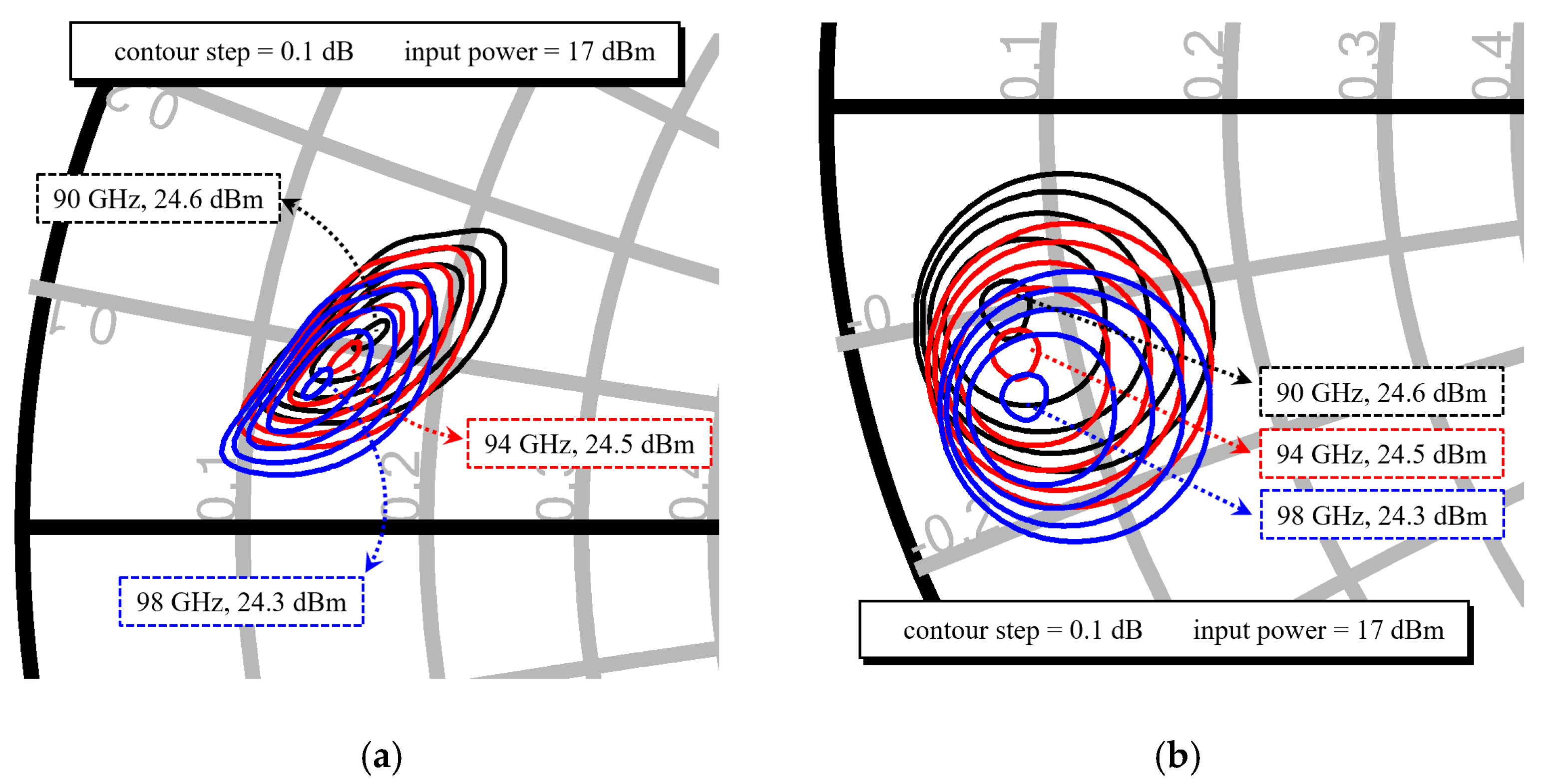
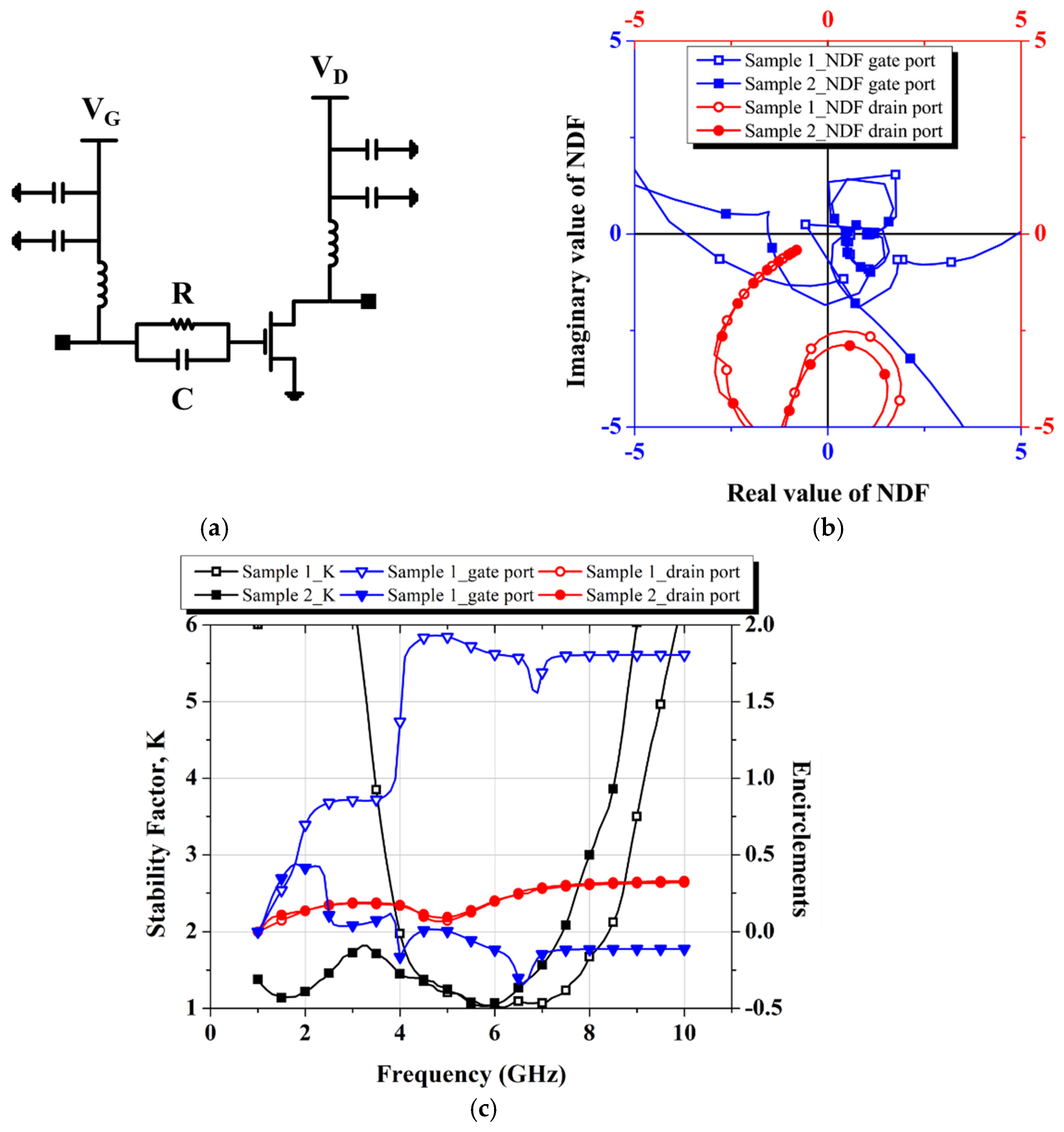

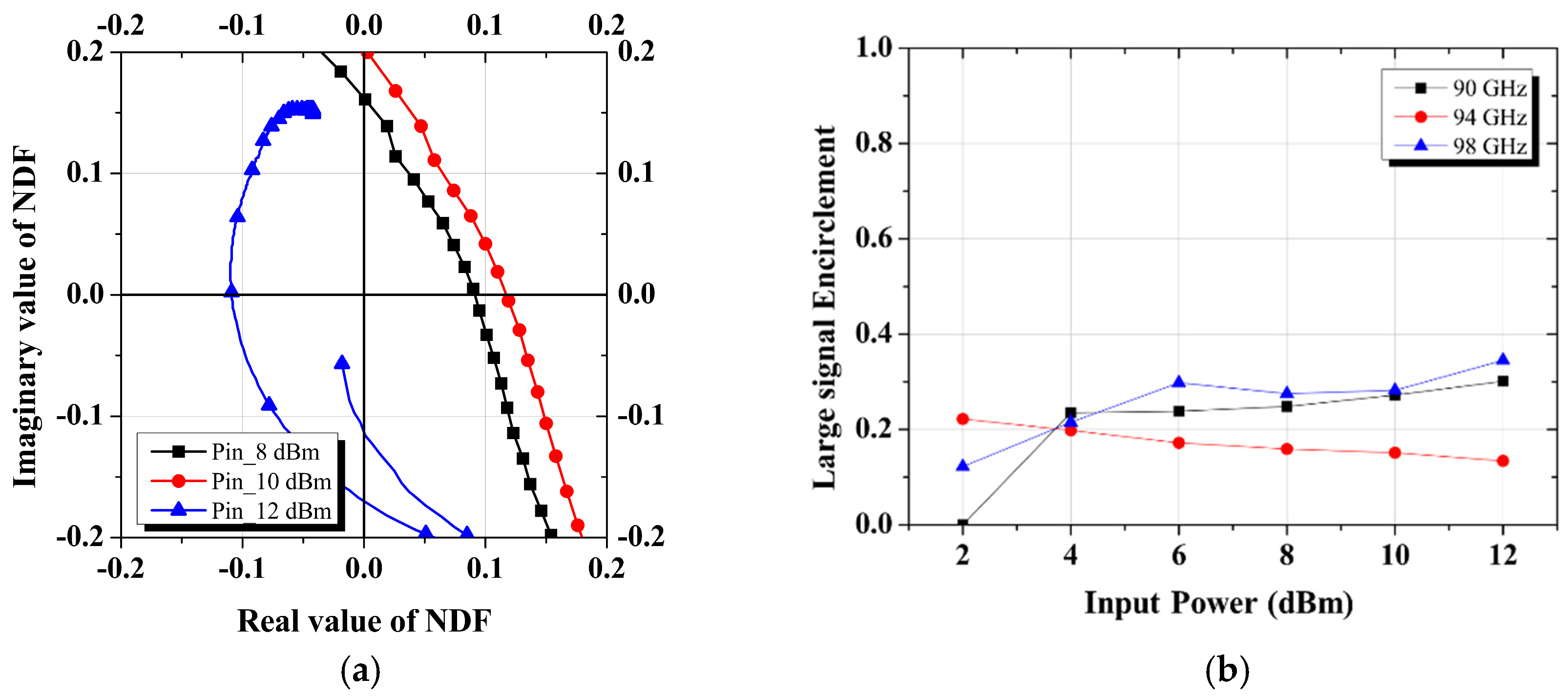

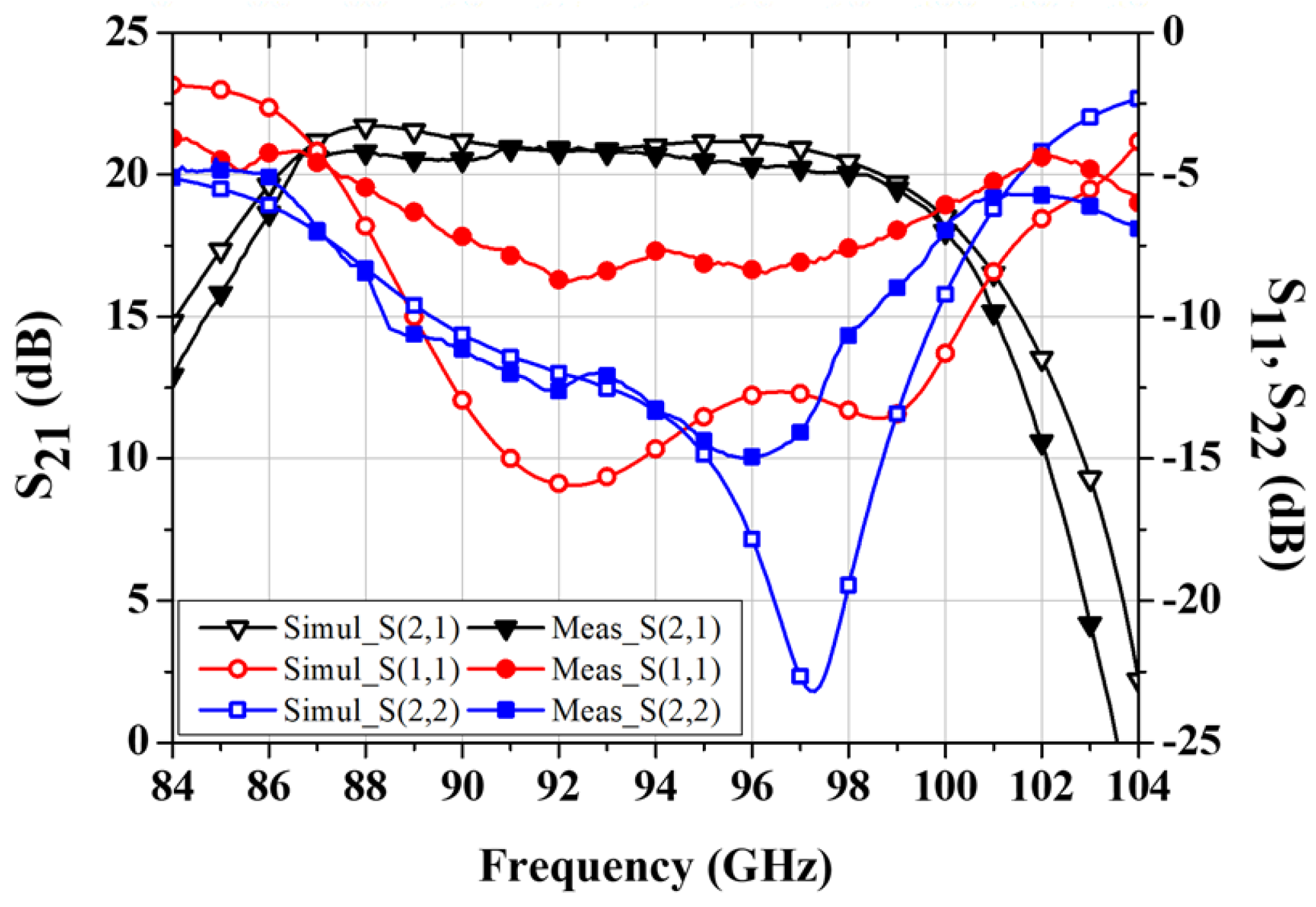
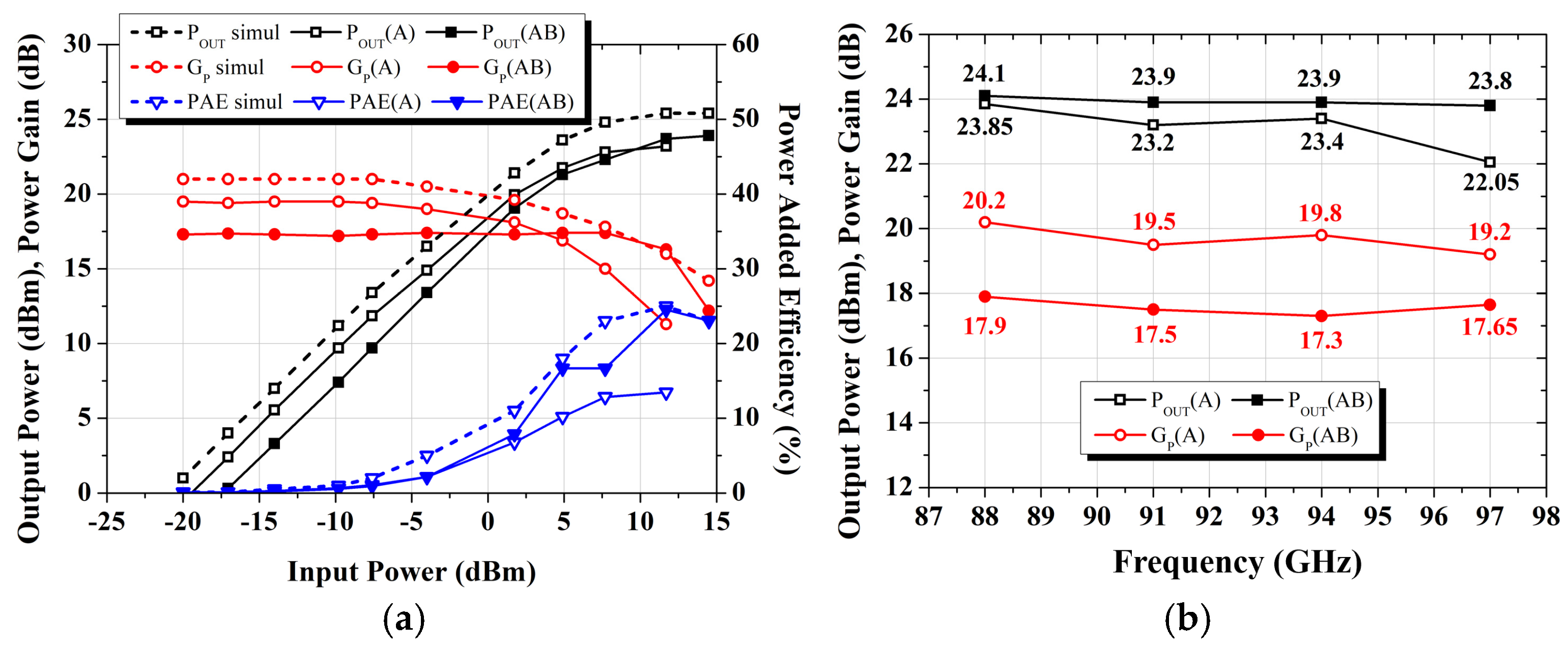
| Work | Frequency (GHz) | Linear Gain (dB) | Output Power (dBm) | DC Power (mW) | PAE (%) | Chip Size (mm2) |
|---|---|---|---|---|---|---|
| [18] | 84–103 | 15 | 21.5 | 1260 | N.A. | 2 mm2 |
| [19] | 75–84 | 25 | 20 | 500 | 10.5 * | 2.1 mm2 |
| [20] | 75–110 | 16.5 | 15.5 | 355 | 9.6 | 5 mm2 |
| [21] | 80–100 | 12 | 24.5 | 350 | N.A. | 3.5 mm2 |
| [22] | 80–98 | ≥20 | 20 | 158 | 13.3 | 3.72 mm2 |
| This work | 88–97 | ≥20 | 22.1–23.9 (gain mode) | 1440 | 13 | 2.6 mm2 |
| 23.8–24.1 (power mode) | 1010 | 24 |
Disclaimer/Publisher’s Note: The statements, opinions and data contained in all publications are solely those of the individual author(s) and contributor(s) and not of MDPI and/or the editor(s). MDPI and/or the editor(s) disclaim responsibility for any injury to people or property resulting from any ideas, methods, instructions or products referred to in the content. |
© 2025 by the authors. Licensee MDPI, Basel, Switzerland. This article is an open access article distributed under the terms and conditions of the Creative Commons Attribution (CC BY) license (https://creativecommons.org/licenses/by/4.0/).
Share and Cite
Han, S.-H.; Kim, D.-W. W-Band GaAs pHEMT Power Amplifier MMIC Stabilized Using Network Determinant Function. Micromachines 2025, 16, 81. https://doi.org/10.3390/mi16010081
Han S-H, Kim D-W. W-Band GaAs pHEMT Power Amplifier MMIC Stabilized Using Network Determinant Function. Micromachines. 2025; 16(1):81. https://doi.org/10.3390/mi16010081
Chicago/Turabian StyleHan, Seong-Hee, and Dong-Wook Kim. 2025. "W-Band GaAs pHEMT Power Amplifier MMIC Stabilized Using Network Determinant Function" Micromachines 16, no. 1: 81. https://doi.org/10.3390/mi16010081
APA StyleHan, S.-H., & Kim, D.-W. (2025). W-Band GaAs pHEMT Power Amplifier MMIC Stabilized Using Network Determinant Function. Micromachines, 16(1), 81. https://doi.org/10.3390/mi16010081







